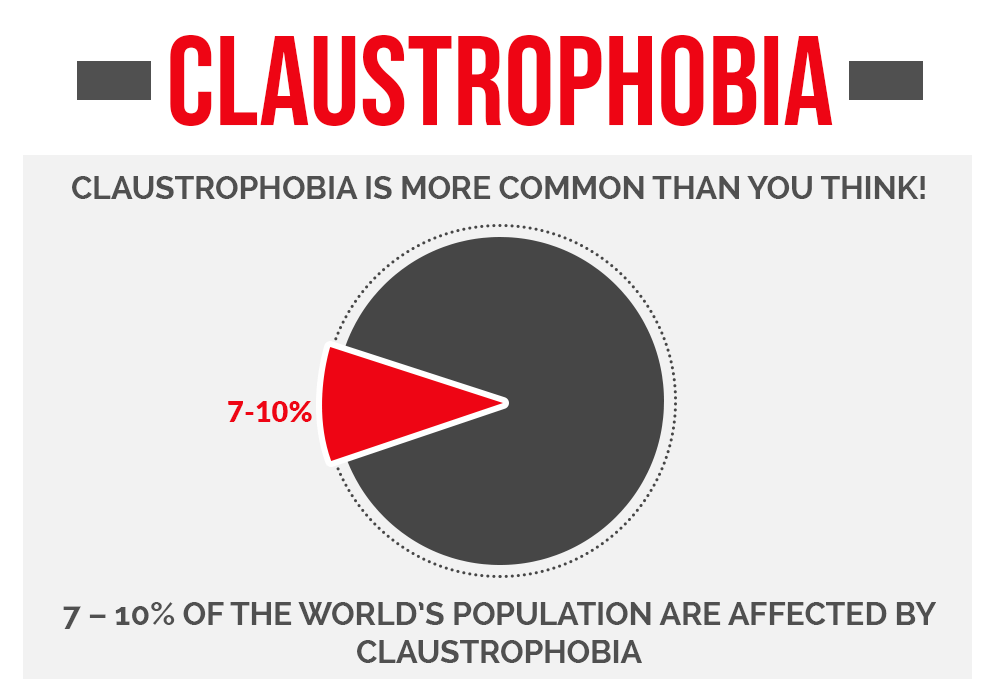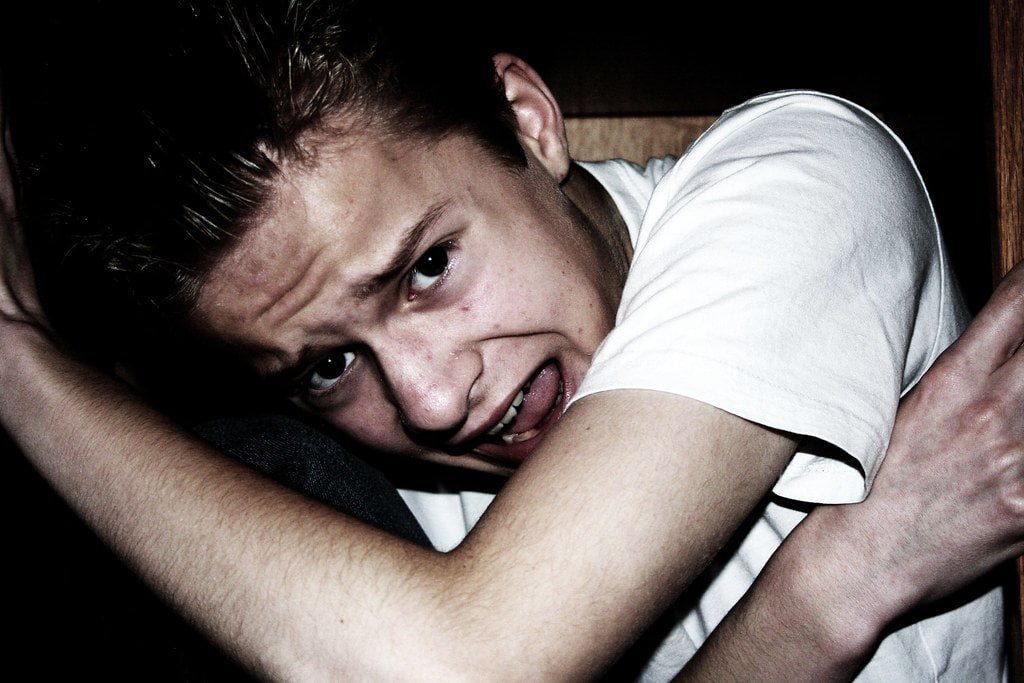Claustrophobia is the situational responsiveness to being confined in small, enclosed or crowded spaces. The most common ways in which you feel claustrophobic are anxiety attacks and the fear of losing control. Studies from The National Center for the Treatment of Phobias, Anxiety, and Depression reveal that nearly 7 – 10% of the world’s population is affected by Claustrophobia! This accounts for a huge number of people but remains to be unperceived and often overlooked. Being claustrophobic can badly restrict your life, for you will fail to experience several joyous moments. These may have detrimental effects on your mental health.

Symptoms of Claustrophobia –
There are several situational responses when a claustrophobic person gets triggered in an enclosed or small environment like a confined room locked from outside or a stuck lift because of no power. Most of the time, the severity of the phobia is determined by the seriousness of the person’s reaction. Some of the major symptoms of Claustrophobia that you need to be wary of are given below.
- Sweating
- Trembling
- Hot Flashes
- Chills
- Shortness of Breath
- Choking Sensation
- Increased Heart Rate
- Chest Pain Leading to Breathing Difficulty
- Nausea
- Feeling of Butterflies in your Stomach
- Dizziness
- Hyperventilation
- Headache
- Frozen in Fear
- Numbness
- Dry Mouth
- Urge to Use Restroom
- Feeling Perplexed
- Numbness
The psychologically worrisome symptoms include,
- Fear of Losing Control
- Fear of Fainting
- Fear of Dread
- Fear of Dying
What Causes Claustrophobia –
Though there hasn’t been a precise cause for claustrophobia, scientists and doctors have identified several causes that might implant the root of fear inside claustrophobic patients. The following are the four major established causes of Claustrophobia:
1. Distressing Memories
Another major cause of Claustrophobia is found to be a traumatic memory in which a person is exposed to an extremely susceptible environment that would have triggered any one of the claustrophobic symptoms mentioned above. These memories remain forever and any similar conditions might trigger an anxiety attack in the person again. Some of the common examples of such memories include getting stuck in an elevator when you were a child or getting lost in a crowd when you were young.
2. Genetic Inheritance
A 2013 study in Translational Psychiatry revealed that a single mutation on gene causes ‘Claustrophobia-like’ behavior in mice. So it is believed that Claustrophobia can be genetically inherited from your ancestors. If your parents are claustrophobic then you may inherit this genetically.
3. The Amygdala Effect
The Amygdala is a nuclei cluster found in the temporal lobe. Its major function is to interpret information from inside and outside of the body and stimulate the response. When instigated, it can cause intense bursts of emotions. In a claustrophobic person, the Amygdala responds to the phobia as if it’s a physical threat to the person. In such a situation, it takes command over the brain and prompts the fight or flight response. This is known as the Amygdala hijack. The size of the Amygdala is found to influence one’s vulnerability to anxiety attacks. Studies comparing the size of Amygdala between patients have indicated that the size of Amygdala in patients with this disorder is smaller in volume than that of a patient without the disorder.
4. Human Perspicacity
The near-space or the peri-personal space is the region of space immediately surrounding the bodies. The near-space and far space are interpreted differently by the brain. Generally, people with shorter arms have smaller near spaces and people with longer arms tend to have larger near spaces. The study published in the journal Cognition in 2011 revealed that independent of the length of the arm, individuals with a high level of claustrophobic fear have larger near spaces than those with lesser claustrophobic fear. The study also suggests that Claustrophobia may derive from a distortion in the perception of space.
Diagnosis –
Even though Claustrophobia can take a critical toll on your mental health, there is nothing much to be worried about if it is diagnosed properly. If you are aware of the cause of your phobia say, a childhood trauma, you can surely control it. But in some serious cases of claustrophobia, where a patient loses control over himself without being able to suppress the fear, the person must consult a mental health professional.
The specialist helps you figure out the exact cause of your fears. It might be a panic disorder, claustrophobia, or some other issue. In any case, you are always on the safer side if you don’t hesitate to get diagnosed by an expert. Usually, doctors help you identify the cause by asking simple yet vital questions concerning your fear. Using questionnaires is another common way of diagnosis. You may wish to take the self-claustrophobia test given below to check it by yourself whether you are claustrophobic or not.
How to take a Self-Claustrophobia Test –
Considering the symptoms of claustrophobia, doctors usually use a questionnaire to assess your fear. Let us carry out a simple test by asking you some questions. Do a self-analysis honestly and check if you respond to the below situations with panic or with any of the symptoms mentioned at the beginning.
- Staying inside an elevator for a longer time especially at a power cut.
- Locked in a small confined room without windows for 15 minutes.
- Tied up with hands behind the back for 15 minutes.
- Taking a flight.
- Caught in tight clothing and unable to remove it.
- Getting legs tied up to an immovable chair.
- Trying to catch your breath while exercising.
- In a crowded bus/train stopping between stations and you’re not allowed to go out.
- Working under a car for 15 minutes.
- Sitting in the center of a full row at a cinema theater.
- Swimming while wearing a nose plug.
If you find yourself to be anxious in more than 5 of these situations, it is fairly presumable that you might be claustrophobic. Also, the level of anxiety in these circumstances may determine the seriousness of your phobia. In such a case, it will be sensible of you to consult a mental health expert.
Treatments for Claustrophobia –
Claustrophobia can often be treated and cured using psychological therapies. To decide on the right treatment, one must first be diagnosed to know the exact risk it poses. The following are the common ways in which Claustrophobia is treated:
1. Cognitive Behavioral Therapy (CBT)
Cognitive Behavioural Therapy is an evidence-based treatment that means it has been proven effective in many instances. The main conception of CBT is to face your fears. This therapy is far simpler than you would’ve thought. All you need to understand about this therapy is that you ought to know what’s happening inside your brain and find a way to do the opposite of what your brain is telling you to do.
2. Rational Emotive Behavior Therapy (REBT)
Rational Emotive Behavior Therapy was invented by Albert Ellis. This therapy helps you realize the irrational fears lurking in your mind and helps you to overcome the fear by rationalizing your brain from imagining improbable events like fear of losing control over yourself in a harmless environment. It makes you ask questions to yourself and dispute the irrational beliefs.
3. Relaxation and Visualization
This technique involves diverting your brain’s attention towards a more positive scenario or engaging in some other mental task like counting down from 10. This is a guided imagery and visualization technique that has proven to be efficient in treating patients with many sorts of anxiety disorders including Claustrophobia.
4. Exposure Therapy
Exposure Therapy is a technique in behavioral therapy that encourages methodical confrontation of the feared stimuli which could be external or internal. It involves exposing the patient to the source of his fears and helping him gradually overcome it. This process has proved to be extremely effective and often suggested as a first-line treatment. But it remains to be an underutilized method in medical practice.
5. Medicinal Treatment
The medication prescribed for anxiety disorders is often used in unison with the therapies. The medication might be a short term or long term option based on the seriousness of the symptoms. They are proved to be extremely effective in suppressing the symptoms for a transient period. The antidepressants and relaxants have proved to be extremely beneficial while traveling. Though this isn’t a permanent cure, they are efficient when used alongside therapies.
Tips on How to Manage Claustrophobia –
If you find yourself in one of the spaces that might trigger your disorder, you will find these tips advantageous in overcoming your claustrophobic fear at that circumstance.
- Take deep and slow breaths by counting up to 3.
- Try to convince yourself that you are in a harmless situation.
- Shift your attention towards something else like time passing or singing a song.
- Visualize sceneries or other places that calm your mind.
- Recollect your memories and picture your favorite moments.
- Remember that your fear and anxiety won’t last long.
- Meditating and doing yoga might do wonders in calming you.
- Exercising and hitting the gym gives you a steady control over yourself.
- A few sips of water in anxious moments will help you clear your mind.
- A healthy conversation with someone with similar experience and sharing your stories with them will help you feel better.
- This might sound offbeat but a small jig with some music might influence your emotional state.
- The final and the important thing is that never let fear control you. Never put pressure on yourself and give yourself time to get better.
We hope you find this article helpful in providing you a clear understanding of Claustrophobia and how to handle it. Here are some of the most common questions about Claustrophobia that you may need an answer for:
FAQs
Frequently Asked Questions on Claustrophobia –
1. How to know if you are Claustrophobic?
Answer: If you come across symptoms like sweating, shivering, chills, anxiety or any other symptoms mentioned earlier when exposed to a confined environment like an elevator, there are chances that you might be claustrophobic. We strongly recommend you to take the self-claustrophobia test given above.
2. What is an example of Claustrophobia?
Answer: Feeling anxious and panic inside an elevator, hyperventilating in a confined environment, shortness of breath in a crowded place, hesitation in taking a flight, are some of the examples of Claustrophobia.
3. Is Claustrophobia curable?
Answer: There are several ways of treating Claustrophobia. The most effective way is CBT and Visualization. Other psychological therapies given above have also proven to be very effective.
4. What is the difference between Claustrophobia and Cleithrophobia?
Answer: Cleithrophobia is the fear of being trapped whereas Claustrophobia is the fear of enclosed spaces. For example, getting scanned in an MRI might trigger a claustrophobic patient but not a patient affected by Cleithrophobia.
5. Is Claustrophobia a mental illness or disability?
Answer: Claustrophobia is a form of anxiety disorder and related to mental health which is very common. But you may be surprised to learn that Claustrophobia is considered a disability according to the Americans with Disabilities Act.
6. How can I treat Claustrophobia naturally?
Answer: If you are claustrophobic, you can follow simple procedures like taking deep breaths, picturing positive moments, visualizing calming sceneries when you find yourself in such circumstances. Bringing Meditation and Exercise as part of daily routine will definitely help!
You may also be interested in reading How to Lose Face Fat: 10 Effective Tips
You may also be interested in reading Natural Remedies for Cough: 11 Proven and Highly Effective Ways.


